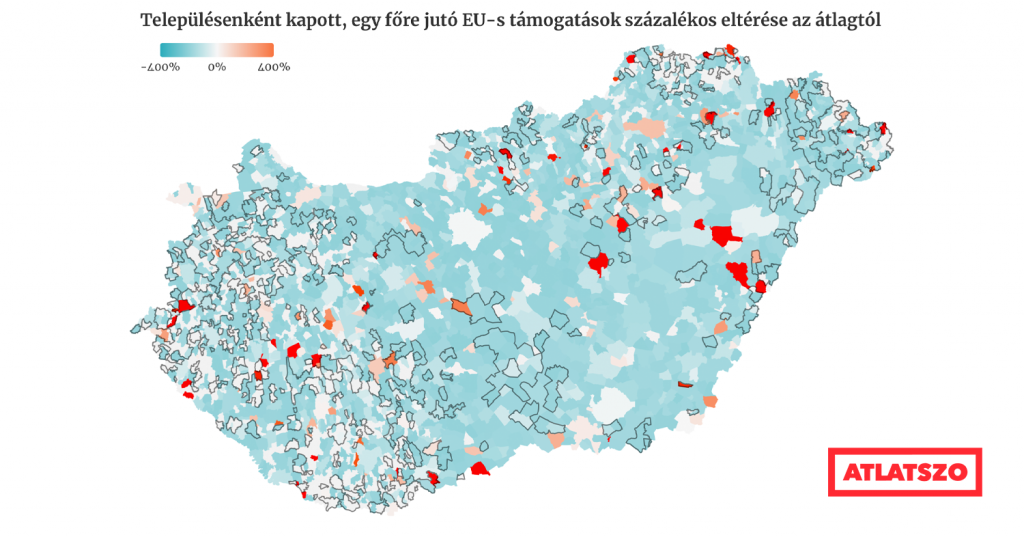The https://english.atlatszo.hu use cookies to track and profile customers such as action tags and pixel tracking on our website to assist our marketing. On our website we use technical, analytical, marketing and preference cookies. These are necessary for our site to work properly and to give us inforamation about how our site is used. See Cookies Policy
These are the districts to watch out for on 3 April – Atlatszo’s analysis of the Hungarian election
With only a few days to go until the parliamentary elections in Hungary on 3 April, we show you which electoral districts to look out for on election day, and also map the growth of the governing party (Fidesz) in the previous cycle. The results does not support the theory that the nearly five hundred districts suspected of mobilisation were from the poorest regions of the country. Rather, what is striking is that the voting patterns that were previously concentrated in the most vulnerable areas have spread to other regions.
Two weeks ago, Átlátszó published a database suggesting that Fidesz is preparing a major mobilisation in Borsod district 5 and presumably everywhere else.

Leaked database indicates that Fidesz is preparing a huge mobilisation in Borsod-Abaúj-Zemplén county
According to a database obtained by Átlátszó, Fidesz is preparing statistics covering all settlements in the parliamentary constituency No. 5 of Borsod-Abaúj-Zemplén county on the voters and supporters of Fidesz MP Richárd Hörcsik. The table shows that the party HQ’s expectations for 2022 are higher than the 2018 result.
Which is not surprising, either in the light of experience so far, or of the lessons learned from the compilation we have made on the nature and functioning of the ‘system of national cooperation’ (in Hungarian: Nemzeti Együttműködés Rendszere, or NER).
Elections in an illiberal democracy – the reality of the current Hungarian political system
Over the past 12 years, it has been said many times that something has changed in Hungary, that there is no longer any rule of law or democracy. In contrast, before elections, opposition parties enter the contect and the media report on the events as if they were a ‘normal’ multi-party contest, with the only difficulty being the electoral system.
Shortly afterwards, the Electoral Geography Facebook page published a compilation of the districts in which they believe mobilisation took place on election day 4 years ago.
The Hungarian national elections will be held on April 3, 2022, the currently ruling party (Fidesz-KDNP) led by PM Viktor Orbán is expected to face a six-party opposition coalition that has selected conservative politician Péter Márki-Zay as its joint candidate for prime minister during the opposition primaries held in 2021.
It was noted that in some districts (typically villages), the turnout was different from the national trend, with a sudden surge in voting in the morning hours. They identified 493 ‘suspicious’ constituencies among which 52 per cent of which are settlements with less than 1,000 inhabitants.
We looked at the districts in question and found that, broadly speaking, voting was no different in 2010. Since then, neither the dynamics nor the proportions have changed significantly in the small settlements and segregated areas: there has been a more modest increase in turnout and, correspondingly, in the number of votes cast for Fidesz.
The districts are shown on a map, and the result did not support the theory that the nearly five hundred districts were drawn from the poorest regions of the country. Rather, what is striking is that a voting method that was previously typical of the most vulnerable areas has now spread to other regions.
Where is the two-thirds majority made?
All this is important because the public has a misconception about where Fidesz’s unexpected 2018 surge is coming from. According to this view, the population of the villages lined up behind the government in even greater numbers than before. In fact, Fidesz support has increased in all types of settlements.
Five categories were created in ordet to show the party’s voter base at the settlement level. By village we mean a settlement with less than 5,000 inhabitants, small town we call a town with a population of 5,000 to 15,000, medium town between 15,000 and 50,000, while big town is a town with a population of more than 50,000, and then there is Budapest. It can be seen that in the three urban categories outside Budapest, the growth in votes from 2014 to 2018 exceeds the growth that the villages produced.
What we see for the country as a whole is also true for the leaked Zemplén (Borsod 5) district. In fact, the it clearly shows that the election will not be decided in villages but in small and medium-sized towns. According to an expert we interviewed, “what is interesting is that the [Fidesz] centre’s expectation for 2022 is higher than the 2018 figure. “If they can deliver that, it will be a brutal result”.
The number of votes cast for Fidesz increased in most places
Last year, when we analysed the electoral districts and then divided them into three categories (Fidesz, opposition, battleground) in terms of its chances based on past results. We have called swing (or battlefield) districts those that could still swing either way, i.e. where a tight contest is expected. We also pointed out that it remains a question whether this tendency has continued after 2018, or whether the political situation has been roughly balanced in terms of opposition-government party strength.
What we clearly see is that Fidesz has significantly redrawn the electoral districts during this period. There were only five constituencies where the number of votes cast for the governing party decreased, and a further 11 where the number of votes cast for the opposition increased, but the increase was less than the increase in the number of votes cast for the opposition.
The increase in the number of votes for the Fidesz in the previous cycle is also shown on a map.
Where does the money go?
However, an interesting phenomenon can be seen when we look at EU funds spent at the level of municipalities. In Borsod district 5, Fidesz support has not increased much, and we can see that the EU money spent in the previous cycle is also below the local and national average.
We see a very similar phenomenon, for example, in the 4th district of Békés, i.e. Orosháza. Here, György Simonka (was) a representative, who is facing criminal proceedings for misuse of EU funds.
The deviation from the average percentage of EU funds per capita by municipality is also shown on a map:
On Election Day, in addition to monitoring turnout, of course, and looking for and analysing national results, Atlatszo will focus on districts where what we have written about types of municipalities and EU funding is true.
Translated by Zita Szopkó. The original, Hungarian version of this article was written by Krisztián Szabó and András Hont, and can be found here.
Hungary. What do you know about Hungary? from atlatszo.hu on Vimeo.


